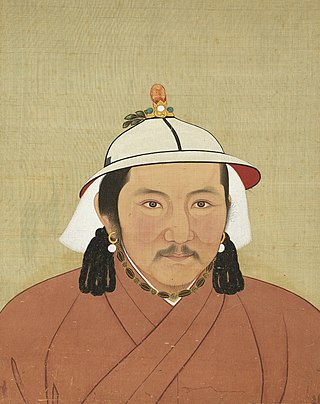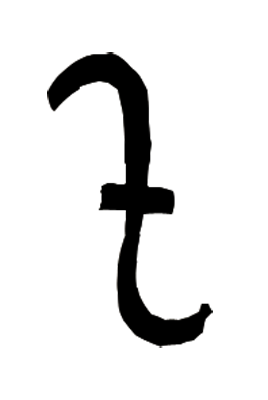Related Research Articles
Uskhal Khan, also called the Last Lord of Northern Yuan or by his era name the Tianyuan Emperor, born Tögüs Temür, was an emperor of the Northern Yuan dynasty, reigning from 1378 to 1388. He was the last powerful khagan of the Mongols until Dayan Khan.

Budashiri or Buddhashiri was Empress of China and Khatun of Mongols as the wife of Jayaatu Khan Tugh Temür. She acted as an interim regent and was the prominent figure of the Yuan dynasty between 1332 and 1339; she was interim regent after the death of her husband and the election of his successor in 1332-1333, and then regent during the minority of his successor in 1333-1339.

Toghon Temür, also known by his temple name as the Emperor Huizong of Yuan bestowed by the Northern Yuan dynasty and by his posthumous name as the Emperor Shun of Yuan bestowed by the Ming dynasty, was the last emperor of the Yuan dynasty and later the first emperor of the Northern Yuan dynasty. Apart from Emperor of China, he is also considered the last Khagan of the Mongol Empire. He was a son of Kusala.
Khutughtu Khan, born Kuśala, also known by his temple name as the Emperor Mingzong of Yuan, was a son of Khayishan who seized the throne of the Yuan dynasty of China in 1329, but died in suspicious circumstances six months later. Apart from the Emperor of China, he is considered as the 13th Great Khan of the Mongol Empire, although it was only nominal due to the division of the empire.

Jayaatu Khan, born Tugh Temür, also known by his temple name as the Emperor Wenzong of Yuan, was an emperor of the Yuan dynasty of China. Apart from Emperor of China, he is regarded as the 12th Khagan of the Mongol Empire, although it was only nominal due to the division of the empire.
Yesün Temür was a great-grandson of Kublai Khan and an emperor of the Yuan dynasty of China from 1323 to 1328. Apart from Emperor of China, he is regarded as the 10th Khagan of the Mongol Empire, although it was only nominal due to the division of the empire. In Chinese historiography, Yesün Temür, who was very fond of the traditional ways of the Mongols, is commonly known as the Taiding Emperor of Yuan based on his first era name. His name means "nine iron" in the Mongolian language.

Ariq Böke, the components of his name also spelled Arigh, Arik and Bukha, Buka, was the seventh and youngest son of Tolui and a grandson of Genghis Khan. After the death of his brother the Great Khan Möngke, Ariq Böke claimed the title of the Great Khan of the Mongol Empire and briefly took power while his brothers Kublai and Hulagu were absent from the Mongolian Plateau. When Kublai returned for an election in 1260, rival factions could not agree, and elected both claimants, Kublai and Ariq Böke, to the throne, resulting in the Toluid Civil War that fragmented the Mongol Empire. Ariq Böke was supported by the traditionalists of the Mongol Empire, while his brother Kublai was supported by the senior princes of North China and Manchuria.
Barchuq Art Tegin was a ruler, with a title of Idiqut, of the Qocho in Beshbalik, Kara-Khoja, Kumul, Kucha and Karasahr between 1208 and 1235. As a result of his policies, Uyghuria joined the Mongol Empire as its fifth Ulus (district) in 1211.
Engke, (?–1394) was a khagan of the Northern Yuan dynasty, reigning for a brief period from 1391 to 1394. The identity of Engke is the subject of an academic dispute: according to Persian history books that Jorightu was Yesüder and Engke Khan was Yesüder's son succeeding him, while Saghang Sechen believe that the Jorightu and Engke were the same person. Although the Ming Dynasty did not know the history of Mongolia during the reign of Tögüs Temür to Gün Temür, Yongle Emperor claimed that there were five khans during this period, confirming that Jorightu and Engke were two generations. His name "Engke" means "Peaceful" in the Mongolian language.

The House of Ögedei, sometimes called the Ögedeids, was an influential Mongol family and a branch of the Borjigin clan from the 12th to 14th centuries. They were descended from Ögedei, a son of Genghis Khan who succeeded his father to become the second khagan of the Mongol Empire. Ögedei continued the expansion of the Mongol Empire.

Kara Del or Qara Del was a Mongol-led kingdom that existed in Qamil or Hami, in present-day Xinjiang. It was founded by the Yuan prince Gunashiri, a descendant of Chagatai Khan, in the late 14th century, and ruled by the Chagatayids thereafter until 1463. From 1380, it began to pay tribute to the Ming dynasty. From 1406, it was governed by Ming under the "Hami Guard" ; however, sometimes it was still under the influence of the Northern Yuan, and the ruler was called the Obedient King under the Jimi system. It was destroyed in 1513 as a result of the wars between the Ming dynasty and the Oirats, as well as dynastic succession struggles. Kara Del means "black chest" in the Old Mongol language.

The Yuan dynasty ruled over the Mongolian Plateau, including both Inner and Outer Mongolia as well as part of southern Siberia, between 1271 and 1368. The Mongolian Plateau is where the ruling Mongol Borjigin clan of the Yuan dynasty came from, thus it enjoyed a somewhat special status during the Yuan dynasty, although the capital of the dynasty had been moved from Karakorum to Khanbaliq since the beginning of Kublai Khan's reign, and Mongolia had been converted into a regular province, known as the Lingbei Province, by the early 14th century.
The War of the Two Capitals, or the Tianli Incident, was a war of succession that occurred in 1328 in the Yuan dynasty. It was a war of succession fought between the forces based in the Yuan capital Khanbaliq and the forces based in the summer capital Shangdu after the death of Yuan emperor Yesün Temür in Shangdu. The clash between the two groups was the bloodiest and most destructive succession in all of Yuan history. The War of the Two Capitals was less about ideology and more a struggle to advance individual family interests through political alliances and military strength. It ended with victory for the Khanbaliq group, but it took a few years for the last remnants of its opponents to give up.
Chaghan Temur, Courtesy name Tingrui (廷瑞), also known by his sinicized name Li Chaghan, was a Yuan dynasty officer and military leader of Naiman Mongol tribe.
Toghon was the ninth son of Kublai Khan, founder of the Yuan dynasty. He was a commander of the Mongol forces in the Mongol invasions of Vietnam.
Park Bul-hwa or Piao Buhua was a Korean eunuch serving Empress Gi of the Yuan dynasty. He was the first ethnic Korean eunuch in Chinese history. Bak assisted Empress Gi's campaign to force Toghon Temür to pass the imperial throne to her son, Ayushiridara.

Zhizheng was the third era name (nianhao) of Toghon Temür, Emperor Shun of Yuan, and was also the Yuan dynasty's final era name. It was used for a total of 30 years. On 23 May 1370, Biligtü Khan, Emperor Zhaozong of Yuan ascended the throne and continued to use it.
Bolad Temür was a warlord of the Yuan dynasty of China. His daughter, Bayan Khutugh, was the second wife of emperor Toghon Temür.
References
- ↑ Lane, George (2018). A Short History of the Mongols. Bloomsbury Publishing. p. 183. ISBN 978-1-78076-606-5.
- ↑ Rossabi, Morris (23 May 2013). Eurasian Influences on Yuan China. p. 170. ISBN 978-981-4459-72-3 . Retrieved 14 August 2014.
- ↑ Atwood, Christopher P. (2004). Encyclopedia of Mongolia and the Mongol Empire . ISBN 0-8160-4671-9.
- ↑ "Empress Ki: Character Introductions". 3 November 2013.
- ↑ Louis Hambis (1954). Le chapitre CVIII du Yuan che : les fiefs attribués aux membres de la famille impériale et aux ministres de la cour mongole d'après l'histoire chinoise officielle de la dynastie mongole. Monographies du Tʿoung pao, v. 3. Tableau15, généalogie des princes.